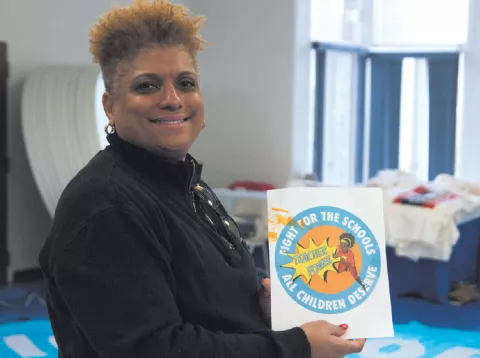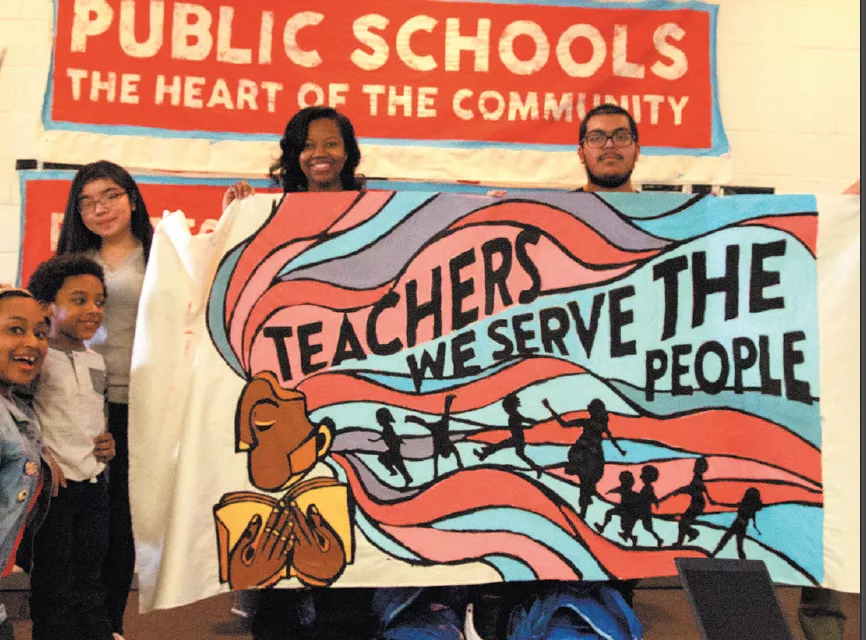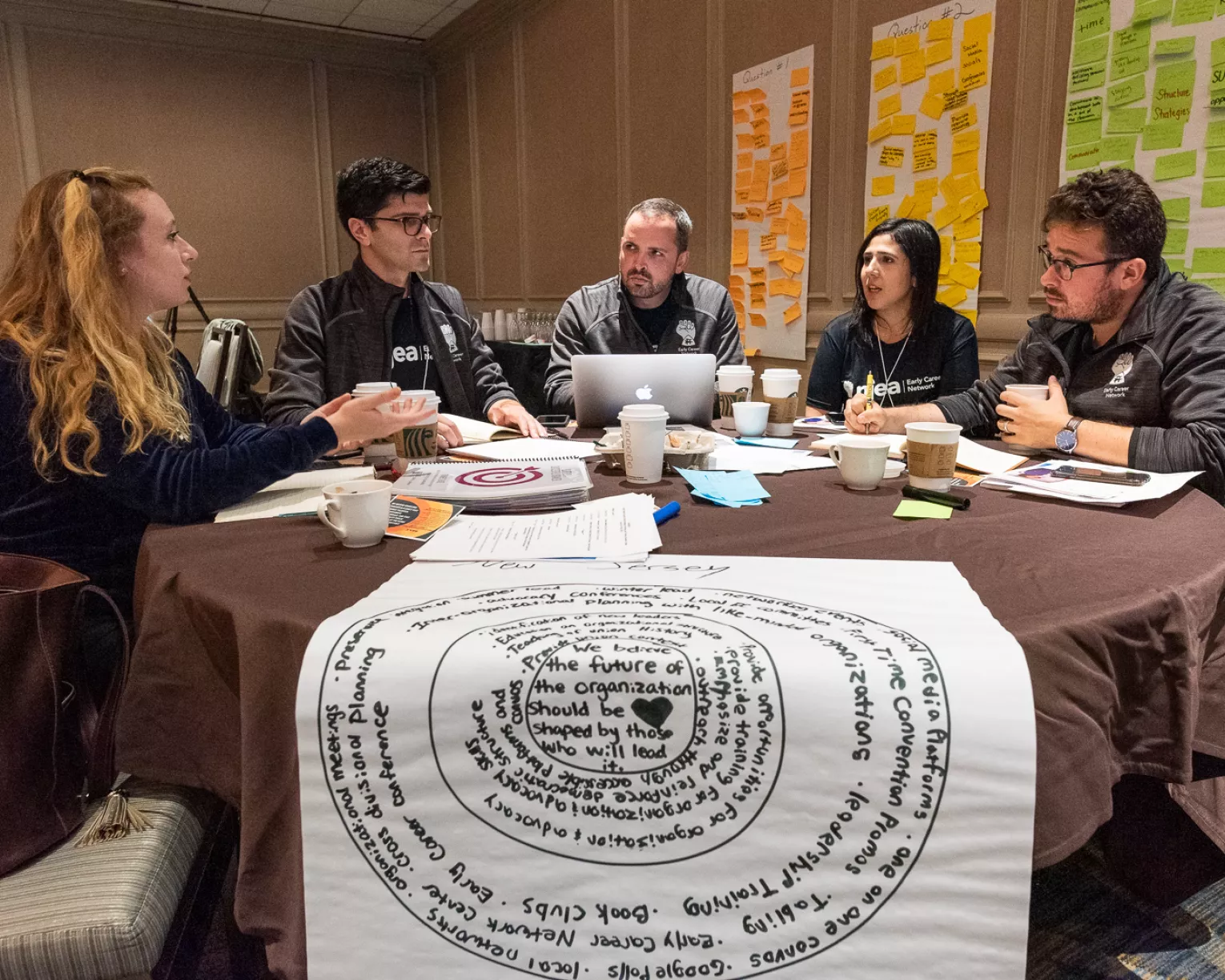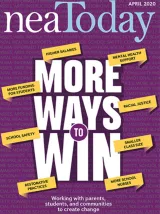We’re going to need a bigger table. The days when a few district and union representatives sat at the bargaining table—hammering out the details of a contract behind closed doors—are long gone. Now the doors are open wide as educators offer the public a seat at the table.
Over the past few years, we’ve witnessed powerful community-wide crusades for better public schools. In bargaining and non-bargaining states alike, parents, students, educators, and community activists have united to fight for everything from smaller class sizes and mental health supports to school safety, racial justice, fair wages, and more.
Some wins have made a major media splash and reaped huge gains, while many others created subtle, yet significant, ripple effects. But all of this work requires years of planning, participation from parents and the community, and a steady growth of union power.
This historic movement recognizes that student success in the classroom is intrinsically linked to the success of their communities. You simply can’t have one without the other.
The following stories highlight big wins, small victories, and the building blocks of change. And all show how NEA local affiliates, schools, and communities have joined together to reimagine union advocacy. It’s no longer about pay and benefits alone; it’s about something bigger—creating positive change for the common good.

Uniting for Equity
- THE CHALLENGE: Unequal pay and a rampant school-to-prison pipeline in Prince George’s County, Md.
- THE ACTION: Invited all union members and parents to bargaining sessions; community-wide activism.
- THE OUTCOME: Won raises, restorative practices, and comprehensive changes; earned community goodwill.
When the Prince George’s County Education Association (PGCEA) sat down at the bargaining table last year, it invited all 10,000 union members, plus local parents and students, to attend. “Open bargaining,” as it’s known, was a change for PGCEA, but President Theresa Dudley believes it makes sense for her community.
“No more smoke and mirrors in the back room,” Dudley promised in a video message. “You really want to know what we’re negotiating for? We’re negotiating for great places for our children to learn.”

The Maryland local, situated east of Washington, D.C., in a school district where more than 90 percent of students are black and Hispanic, also made public its contract demands. They aimed for fair compensation—teachers here were earn- ing an average of $10,000 less than teachers in an adjacent district. And, in work supported by an NEA Student-Centered
Bargaining and Advocacy Grant (nea.org/scba-grants), the local also called for healthier learning environments, includ- ing smaller class sizes, less testing, and training for restorative practices—which is shown to lower suspension rates and disrupt the school-to-prison pipeline for students of color.
A Community Takes Action
Inspired by the St. Paul Federation of Teachers and the Milwaukee Teachers’ Education Association—which partnered with communities to fight for better schools—PGCEA held town-hall meetings in early 2019 and released its bargaining for the common good platform to the public.
The first open-bargaining session, packed with red- shirted #RedForEd supporters, took place in February. In March, PGCEA pulled together parents and students for an energetic art build that produced hundreds of vibrant protest signs and banners. Nearly 2,000 PGCEA members, parents, and students then waved the signs as they marched through the streets of Annapolis, the state capital. The community effort led legislators to approve an additional $53 million in state education funds for Prince George’s County.
In April, union supporters sent more than 1,000 letters to the county council and school board. On May 8, a day celebrated as Teacher Appreciation Day, PGCEA promoted a first-ever “Teacher Unappreciation Day,” pointing to the years of disrespect—and low pay—endured by educators.
All of this led to a powerful May deal providing nearly $124 million in pay raises, including $39 million toward restoring raises the county skipped during the recession. For some, this adds up to a 22.5 percent pay raise over three years.
And that’s not all! The union won improvements across the board, including: an additional five days for special education teachers to complete IEPs (individual education programs) and other paperwork; a new task force to establish appropriate teacher-to-student ratios, plus reasonable caseloads for counselors, psychologists, and social workers; an evaluation system focused on professional growth; and the expansion of restorative practices to schools with interested faculty.
And none of it ends here: “We’re in this for the long haul,” promises Dudley.
—MARY ELLEN FLANNERY
Lifting Up LGBTQ Educator Voices
- THE CHALLENGE: An outdated anti-discrimination policy in Jefferson County, Colo.
- THE ACTION: Pushed the school district to create a safer environment for LGBTQ students and educators.
- THE OUTCOME: Established an LGBTQ Caucus and “Safe Spaces” trainings for members.
When it comes to bargaining for the common good, some wins come in pieces and take time—like a recent victory in Jefferson County Public Schools ( Jeffco) in Colorado.
Similar to many school districts nationwide, Jeffco has an anti-discrimination policy in place. Still, in 2018, union officials learned that some lesbian, gay, bisexual, transgender, and questioning (LGBTQ) educators have been told to keep silent about their identities or have experienced discrimination.
The Jefferson County Education Association ( JCEA) wasted no time in taking action.
“It’s not enough to say, ‘we support everybody,’” says Sandi Leggitt, an English language arts teacher at Alameda International Jr./Sr. High in Lakewood, Colo. “It’s not enough to have a policy that simply reminds people
it’s federally illegal to discriminate—we know it’s illegal. The current policy doesn’t keep discrimination from happening, and we need to outwardly support our LGBTQ+ students and educators.”
A Small Victory With Big Impact
In 2018, JCEA members demanded that the school district—the second largest in Colorado—update its anti-discrimination policy. And while the union waited for a response, they organized.
JCEA held several LGBTQ educator meetups; started an LGBTQ caucus to help educate and empower the LGBTQ community; partnered with the local PTA and child and LGBTQ advocacy groups; and brought LGBTQ 101 and GLSEN’s (Gay, Lesbian & Straight Education Network) “Safe Spaces” trainings to members. These trainings help raise awareness about LGBTQ issues and provide practical ways to transform schools into safer spaces for all students.
“We needed—and still need—to get the message out that our work around LGBTQ advocacy benefits all of our students,” says Leggitt. “We have kids who are identifying as trans in elementary grades, and we need to show them that it’s good for everyone to see teachers being supported and living successful, healthy, and happy lives as an LGBTQ.”
Today, Jeffco’s anti-discrimination policy remains unchanged, but “we are making progress and are effecting change on this issue,” Leggitt says. “We’re a large district, and shifting consciousness of some of our policymakers is going to take time.”
With JCEA’s collective bargaining agreement scheduled to sunset in 2021, officials plan to incorpo- rate new language into their contract that uplifts their work and supports the LGBTQ school community.
This work was supported in part by an NEA My School My Voice organizing grant. For more information, visit nea.org/miniorggrants.
—BRENDA ÁLVAREZ
The Common Good—Explained
Bargaining for the common good (BCG) is about fighting for quality public schools in every neighborhood. NEA’s Dale Templeton, director of Collective Bargaining and Member Advocacy, explains how everyone—in bargaining and non-bargaining states alike—can help unite their communities around improving schools for students.
NEA Today: What is bargaining for the common good?
Dale Templeton: BCG is about transforming the way we bargain and advocate for our students and members.
BCG is about engaging our members and community partners around demands that benefit not only our members, but the wider community as well.
Many state and local affiliates are expanding the scope of bargain- ing—far beyond the contract—to include non-traditional, student-centered issues and topics that may fall outside the realm of public education. Examples include: more nurses and mental health profes- sionals; more recess time; re- duced testing; smaller class sizes; increased funding for education; restorative justice; stopping cor- porate giveaways that impact the community; and more.
Is BCG possible in states that do not allow collective bargaining?
DT: Yes. BCG campaigns can happen everywhere. BCG is about networking and building relationships with parents, civic organizations, and locally elected leaders—and then leveraging that collective power to change policy and regulations.
How can small locals with limited resources organize in their communities?
DT: Sometimes it is easier to start a campaign in smaller locals because the relationships and ties to the community are stronger and people know each other.
The key to success is to start early, engage your community allies from the beginning, determine your goals, plan, and develop your strategy. This is not just about one effort, but rather the beginning of an inclusive community partnership.
Where can I learn more?
DT: For fact sheets, a new video explaining BCG, and a toolkit on student-centered advocacy, go to nea.org/BCG. Further resources are on our partner’s site, bargainingforthecommongood.org. Have questions? Contact NEA’s Collective Bargaining and Member Advocacy department at [email protected].
Upending the Charter School Industry
Glossary of Bargaining Terms
These definitions can help you become fluent in the language of bargaining.
Bargaining for the common good
A strategy in which unions, community groups, and racial justice and student organizations work together as equal partners. They use contract fights to win on issues that benefit union members and the community as a whole.
Bargaining states
When a state law gives public employees a statutory right to bargain with their employer, typically over wages, hours, and working conditions. These laws and rights vary from state to state. Some other states don’t have a collective bargaining law, but some bargaining does take place—this is often referred to as permissive bargaining.
Collective action
An action taken by a group of people with an interest in achieving a common goal.
Collective bargaining
A formal process through which employees and employers negotiate a written agreement, laying out the terms and conditions of work for a particular workplace. This agreement is binding on both parties for a defined period of time.
Community engagement
The process of inviting groups of people to come together to take action on issues of mutual interest that affect that community.
Non-bargaining states
When a state law prohibits collective bargaining altogether, making it illegal to engage in the process.
Open bargaining
Being transparent in the bargaining process, which can include sharing information with union members or allowing all members and the public to attend each bargaining session.
Organizing
Facilitating collective action among a group and empowering others to take onleadership roles.



